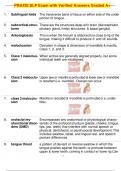PRAXIS SLP Exam with Verified Answers Graded A+
1. Sublingual folds The transverse band of tissue on either side of the under
portion of tongue.
2. subcortical struc- These are the structures deep w/in brain (diencephalon,
tures pituitary gland, limbic structures, & basal ganglia).
3. Ankyloglossia This is when the frenum is attached too close to tip of the
tongue, making it difficult to produce /t/ and /d/ sounds.
4. maloclussion Deviation in shape & dimension of mandible & maxilla.
Class 1, 2, and 3.
5. Class 1 maloclus- When arches are generally aligned properly, but some
sion individual teeth are misaligned.
6. Class 2 malocclu- Upper jaw or maxilla is protruded & lower jaw or mandible
sion is receded (i.e. overbite). Overjet can occur.
7. class 3 malocclu- Maxilla is receded & mandible is protruded (i.e. under-
sion bite).
8. orofacial my- Encompasses any anatomical or physiological charac-
ofunctional disor- teristic of the orofacial structure (palate, cheeks, tongue,
ders (OMD) lips, jaw, teeth) that interfere with normal speech or
physical, dentofacial, or psychosocial development. This
includes swallow, labial, and lingual rest, and speech
posture differences.
9. tongue thrust a pattern of deviant or reverse swallow in which the
tongue pushes against the teeth, or protrude between
upper & lower teeth, coming in contact w/ lower lip.Can
, contribute to the presence of an open bite, where the
upper & lower front teeth do not come together when
the mouth is closed, with opening/dap between upper &
lower teeth when the jaw is closed.
10. pyriform sinus Space between thyroid cartilage & aryepiglottic mem-
brane.
11. valleculae space between tongue and epiglottis.
12. Hippocampus A neural center that helps process explicit memories for
storage, spatial relationships, declarative memory, and
memory encoding.
13. basal ganglia a set of subcortical structures that directs intentional
movements. Disorders of this result in rigidity, jerky,
& purposeless movements (Chorea), & slow, writhing,
snakelike movements (athetosis).
14. Thalamus the brain's sensory switchboard, located on top of the
brainstem; it directs messages to the sensory receiving
areas in the cortex and transmits replies to the cere-
bellum and medulla. Damage to this can cause sensory
issues.
,15. corpus callosum the large band of neural fibers connecting the two brain
hemispheres and carrying messages between them.
Damage to this may result in reading & naming difficul-
ties.
16. Medulla (Myelen- the base of the brainstem; controls heartbeat and breath-
cephalon) ing. Critical for vital functions. Disorders to this structure
would result in trouble breathing & swallowing.
17. Wernicke's area Damage: Left posterior superior temporal gyrus. Expres-
sive lang. consists of neologisms, paraphasia, and intact
prosody.
Receptive language is impaired.
Comprehension & naming difficulties.
Impaired repetition, writing, and reading.
18. Transcortical Mo- Damage: supplementary motor cortex, area just anterior
tor Aphasia to Broca's.
Receptive language is intact.
A condition in which language is not fluent, but the ability
to repeat is retained.
Mainly characterized by expressive language & naming
difficulties.
19. Mississippi Apha- Quick screening test for aphasia that can be adminis-
sia Screening tered verbally & completed w/in 5-15 minutes. Screening
Test (MAST) tool for severe impaired communication & lang. skills.
Designed to detect changes in language abilities over
time. 9 subtests, ranging form 1-10 items per subscale.
, 20. angular gyrus Brodmann area 39. Located in anteroloateral region of
parietal lobe. Transmit visual info to Wernicke's area to
create meaning out of words that are visually percieved.
21. Agraphia Deficit in writing that may be noticed after a stroke.
22. Agnosia Unable to recognize & identify objects or people.
23. Ischemic stroke Caused by a block or interrupted blood supply to the
brain (i.e., thrombosis & embolic- 2 kinds of problems in
blood circulation.)
24. Hemorrhagic Caused by bleeding in brain due to ruptured blood ves-
stroke sels (HTN being a major risk). Intercerebral or intrac-
erebral hemorrhagic stroke consist of this. Have sudden
onset characterized by severe "thunderclap" headache.
25. Thrombot- A collection of materials that blocks the flow of blood
ic/Thrombus (clot), usually due to atherosclerosis.
stroke
26. Atherosclerosis condition in which fatty deposits & cholesterol (plaque)
build up on the inner walls of the arteries, narrowing
arteries & obstructing blood flow.
27. embolic stroke Mass of arterial debris or a clump of tissue from a tumor
that originates somewhere else in body & travel to brain,
getting lodged in smaller artery blocking flow of blood.
28. Intracerebral he- When blood vessels rupture within the brain.
morrhagic stroke
29. subarachnoid he- A type of extracerebral stroke where blood ruptures with-
morrhagic stroke in the meninges.




